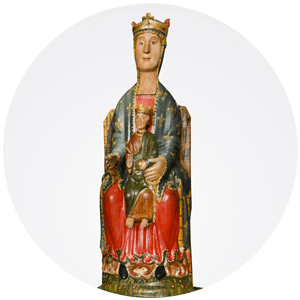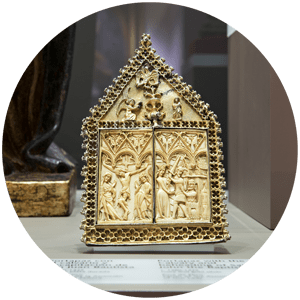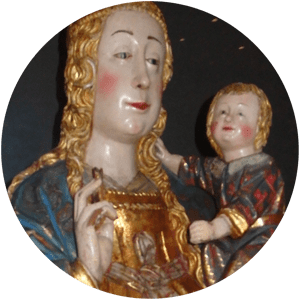This room is the first extension from the Romanesque tour raised after the city conquest by King Alfonso I “the Battler” in 1118. This zone was raised at the end of 12th century by Alphonse II, named “the Chaste”, first king of the Crown of Aragon.
In that moment, the Saint Saviour neighbourhood became into the city centre, where the high clergy and aristocracy took control of the local power.
Coinciding with the Romanesque palace extension, first Christian communities were consolidated and devotion to Virgin Mary was increased. We can appreciate how art evolved with this series of Romanesque and Gothic sculptures from the 12th to 15th century.
This room is the first extension from the Romanesque tour raised after the city conquest by King Alfonso I “the Battler” in 1118. This zone was raised at the end of 12th century by Alphonse II, named “the Chaste”, first king of the Crown of Aragon.
In that moment, the Saint Saviour neighbourhood became into the city centre, where the high clergy and aristocracy took control of the local power.
Coinciding with the Romanesque palace extension, first Christian communities were consolidated and devotion to Virgin Mary was increased. We can appreciate how art evolved with this series of Romanesque and Gothic sculptures from the 12th to 15th century.

![]()
Virgin of Our Lady of the Salz, from 12th century, is a clear example of Romanesque Virgin as a throne of wisdom. It is characteristic its stiffness and its symbolism. The Virgin is represented as a throne for the Savour, her son, and holding a ball in her right hand which symbolises the apple of the original sin, showing the intermediary among God and men. The child Jesus appears sat on her mother’s lap and holding the world in his left hand. With this element, He reaffirms his role as a governor above everything created in the world, and the role of the Virgin gets extended, showing as mother of Jesus child and of God.

Virgin of Our Lady of the Salz, from 12th century, is a clear example of Romanesque Virgin as a throne of wisdom. It is characteristic its stiffness and its symbolism. The Virgin is represented as a throne for the Savour, her son, and holding a ball in her right hand which symbolises the apple of the original sin, showing the intermediary among God and men. The child Jesus appears sat on her mother’s lap and holding the world in his left hand. With this element, He reaffirms his role as a governor above everything created in the world, and the role of the Virgin gets extended, showing as mother of Jesus child and of God.

![]()
Portapaz is a liturgical piece on which the pax or image is presented to be kissed by the pious at mass. With this piece we move back to the late 14th century, when its use increased because of the proliferation of the bubonic plague to avoid contagious among faithful.

Portapaz is a liturgical piece on which the pax or image is presented to be kissed by the pious at mass. With this piece we move back to the late 14th century, when its use increased because of the proliferation of the bubonic plague to avoid contagious among faithful.

![]()
Virgin of the Olive, from the 15th century, is an example of Gothic sculpture. Unlike Romanesque Virgins, it has more humanism, showing an affective relation between mother and son and creating a more emotional scene.

Virgin of the Olive, from the 15th century, is an example of Gothic sculpture. Unlike Romanesque Virgins, it has more humanism, showing an affective relation between mother and son and creating a more emotional scene.
